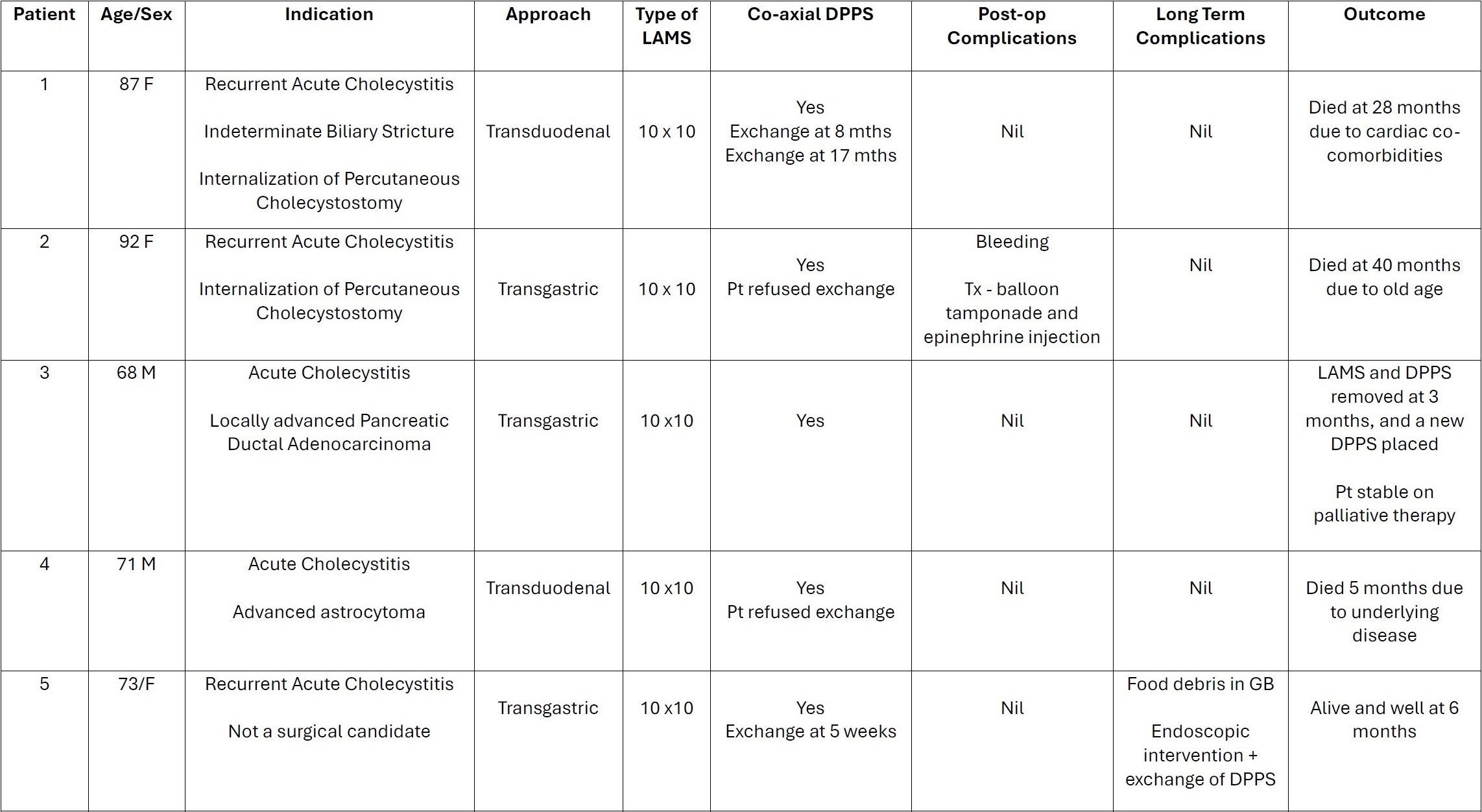Tuesday Poster Session
Category: Interventional Endoscopy
P5730 - EUS-Guided Gallbladder Drainage (EUS-GBD) with LAMS Has Good Long-Term Efficacy and Favorable AE Profile: A Case Series
Tuesday, October 28, 2025
10:30 AM - 4:00 PM PDT
Location: Exhibit Hall
- KM
Karthik Mathialagan, MD
University of Connecticut
Farmington, CT
Presenting Author(s)
Karthik Mathialagan, MD1, Ruchir Paladiya, MBBS2, Murali Dharan, 3
1University of Connecticut, Farmington, CT; 2University of Connecticut School of Medicine, Farmington, CT; 3Employed, Farmington, CT
Introduction: Endoscopic ultrasound-guided gallbladder drainage (EUS-GBD) using lumen-apposing metal stents (LAMS) is a viable alternative for managing gallbladder disease, particularly in high-risk surgical candidates. This involves placing a LAMS from the duodenum or stomach into the gallbladder under EUS guidance, which is usually followed by the placement of a co-axial double-pigtail plastic biliary stent (DPPS) across the LAMS to decrease potential complications. The standard of care involves follow-up peroral cholecystoscopy at 4 to 6 weeks and exchange of the LAMS for a less traumatic plastic stent to maintain the fistula patency. Prolonged indwelling LAMS can lead to stent-related adverse events, including bleeding, stent obstruction, and stent migration, with an overall complication rate of around 20%.
Case Description/
Methods: The study comprised 5 patients with a mean age of 78.2 years (M:F ratio of 2:3) who underwent EUS-GBD with 10 × 10 mm LAMS. The transgastric (TG) approach was used in 3 patients (60%) and the transduodenal (TD) approach in 2 (40%). Co-axial DPPS was placed in all 5 patients (100%) to mitigate the risk of complications. The LAMS was left in situ in all the patients (100%) beyond 6 weeks. 2 patients declined DPPS exchange, whereas 3 underwent interval exchange of the DPPS. Only one patient experienced an immediate post-procedure complication of bleeding, which was managed endoscopically. Similarly, long-term complications were minimal, with 80% of the patients reporting no issues. One patient was noted to have food debris in the gallbladder (on imaging for an unrelated medical problem) that was successfully treated with endoscopic intervention and stent replacement. The duration of LAMS follow-up ranged from 3 to 40 months without any significant long-term adverse effects. The baseline demographics, interventions, and outcomes are shown in Table 1.
Discussion: These observations suggest good long-term safety and adverse event profile for LAMS placement with a coaxial DPPS. Based on the patient's preference and medical comorbidities, EUS-GBD using LAMS can be a destination therapy with minimal adverse events, as the longest patient in our case series was followed up for more than three years. If LAMS is left in situ, the placement of a coaxial DPPS is recommended to mitigate the risk of complications. Periodic exchange of DPPS appears optional based on our data. More studies with larger numbers are needed to confirm our study findings.

Figure: Baseline demographics, interventions, and outcomes of patients undergoing EUS-GBD
Disclosures:
Karthik Mathialagan indicated no relevant financial relationships.
Ruchir Paladiya indicated no relevant financial relationships.
Murali Dharan indicated no relevant financial relationships.
Karthik Mathialagan, MD1, Ruchir Paladiya, MBBS2, Murali Dharan, 3. P5730 - EUS-Guided Gallbladder Drainage (EUS-GBD) with LAMS Has Good Long-Term Efficacy and Favorable AE Profile: A Case Series, ACG 2025 Annual Scientific Meeting Abstracts. Phoenix, AZ: American College of Gastroenterology.
1University of Connecticut, Farmington, CT; 2University of Connecticut School of Medicine, Farmington, CT; 3Employed, Farmington, CT
Introduction: Endoscopic ultrasound-guided gallbladder drainage (EUS-GBD) using lumen-apposing metal stents (LAMS) is a viable alternative for managing gallbladder disease, particularly in high-risk surgical candidates. This involves placing a LAMS from the duodenum or stomach into the gallbladder under EUS guidance, which is usually followed by the placement of a co-axial double-pigtail plastic biliary stent (DPPS) across the LAMS to decrease potential complications. The standard of care involves follow-up peroral cholecystoscopy at 4 to 6 weeks and exchange of the LAMS for a less traumatic plastic stent to maintain the fistula patency. Prolonged indwelling LAMS can lead to stent-related adverse events, including bleeding, stent obstruction, and stent migration, with an overall complication rate of around 20%.
Case Description/
Methods: The study comprised 5 patients with a mean age of 78.2 years (M:F ratio of 2:3) who underwent EUS-GBD with 10 × 10 mm LAMS. The transgastric (TG) approach was used in 3 patients (60%) and the transduodenal (TD) approach in 2 (40%). Co-axial DPPS was placed in all 5 patients (100%) to mitigate the risk of complications. The LAMS was left in situ in all the patients (100%) beyond 6 weeks. 2 patients declined DPPS exchange, whereas 3 underwent interval exchange of the DPPS. Only one patient experienced an immediate post-procedure complication of bleeding, which was managed endoscopically. Similarly, long-term complications were minimal, with 80% of the patients reporting no issues. One patient was noted to have food debris in the gallbladder (on imaging for an unrelated medical problem) that was successfully treated with endoscopic intervention and stent replacement. The duration of LAMS follow-up ranged from 3 to 40 months without any significant long-term adverse effects. The baseline demographics, interventions, and outcomes are shown in Table 1.
Discussion: These observations suggest good long-term safety and adverse event profile for LAMS placement with a coaxial DPPS. Based on the patient's preference and medical comorbidities, EUS-GBD using LAMS can be a destination therapy with minimal adverse events, as the longest patient in our case series was followed up for more than three years. If LAMS is left in situ, the placement of a coaxial DPPS is recommended to mitigate the risk of complications. Periodic exchange of DPPS appears optional based on our data. More studies with larger numbers are needed to confirm our study findings.

Figure: Baseline demographics, interventions, and outcomes of patients undergoing EUS-GBD
Disclosures:
Karthik Mathialagan indicated no relevant financial relationships.
Ruchir Paladiya indicated no relevant financial relationships.
Murali Dharan indicated no relevant financial relationships.
Karthik Mathialagan, MD1, Ruchir Paladiya, MBBS2, Murali Dharan, 3. P5730 - EUS-Guided Gallbladder Drainage (EUS-GBD) with LAMS Has Good Long-Term Efficacy and Favorable AE Profile: A Case Series, ACG 2025 Annual Scientific Meeting Abstracts. Phoenix, AZ: American College of Gastroenterology.
